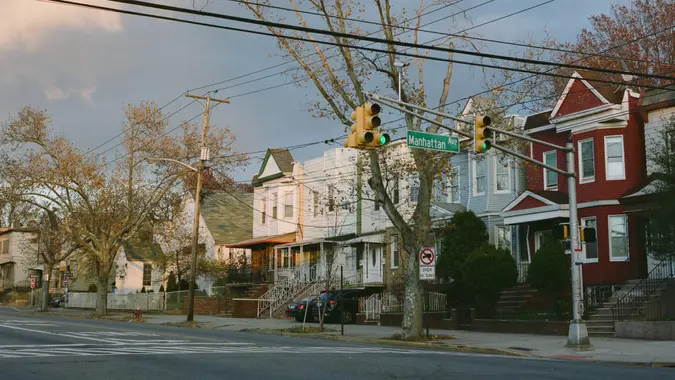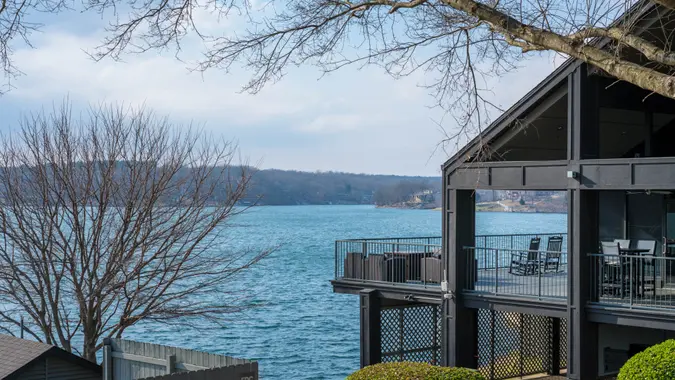Retirement 2025: These Are the 9 Worst Places To Retire in North Carolina

Commitment to Our Readers
GOBankingRates' editorial team is committed to bringing you unbiased reviews and information. We use data-driven methodologies to evaluate financial products and services - our reviews and ratings are not influenced by advertisers. You can read more about our editorial guidelines and our products and services review methodology.

20 Years
Helping You Live Richer

Reviewed
by Experts

Trusted by
Millions of Readers
North Carolina gets pretty high marks as a retirement destination thanks to its combination of affordability, moderate weather, diverse geography and urban centers that offer all the amenities. However, certain places in the Tar Heel State are not ideal for retirees, even as they attract younger people from all over the country.
GOBankingRates did some research to help determine the best and worst places to retire. Though there is no exact science because so many different variables at play, there are different studies and metrics to help you find which places are more likely to land in the “worst” column than the “best” one.
Here’s a look at nine of the worst cities to retire in North Carolina based on factors such as livability index, retirement population, home values, cost of living and more.
1. Monroe
- Retirement-aged population (65 and over): 5,117
- Household median income: $67,265
- Average home value: $340,554
- Total annual cost of living: $48,312
- Livability: 56
Monroe is within the rapidly growing Charlotte metropolitan area. However, GOBankingRates ranked it first on the list of the worst cities to retire in for North Carolina based on a high cost of living to income ratio as well as above-average monthly expenses. This may not be what you want to hear when living on a fixed income.
2. Reidsville
- Retirement-aged population (65 and over): 3,224
- Household median income: $42,702
- Average home value: $189,471
- Total annual cost of living: $35,664
- Livability: 56
Though Reidsville may be ideal for outdoor enthusiasts it also has high humidity, pollen count and hurricane risk. These considerations may make it an unworthy investment for many retirement plans.
3. Laurinburg
- Retirement-aged population (65 and over): 2,676
- Household median income: $39,258
- Average home value: $133,267
- Total annual cost of living: $32,112
- Livability: 56
A great factor about retiring in Laurinburg is that it has a low average monthly mortgage cost coming in at about $788. However, it can come with higher costs and less access to healthcare, which is something seniors should factor into their moving decisions.
4. Roanoke Rapids
- Retirement-aged population (65 and over): 2,718
- Household median income: $53,981
- Average home value: $108,921
- Total annual cost of living: $31,180
- Livability: 56
Roanoke Rapids may be a slightly more affordable place to live compared to other cities in North Carolina, not every part of this more rural area is retirement-ready. There is more limited access to cultural activities, a smaller job market and potentially less diverse healthcare options or access.
5. Statesville
- Retirement-aged population (65 and over): 4,972
- Household median income: $55,492
- Average home value: $277,377
- Total annual cost of living: $44,244
- Livability: 58
Statesville is another city on the I-77 corridor that is located just north of Mooresville. It is more affordable than its neighbors to the south, but it rates low in livability and lacks the amenities found in bigger North Carolina cities.
6. Kinston
- Retirement-aged population (65 and over): 4,722
- Household median income: $35,250
- Average home value: $136,256
- Total annual cost of living: $32,948
- Livability: 58
Kinston offers retired residents a sparse suburban feel and has a high population of renters. However, homeowners can expect an average mortgage of $805 a month plus an estimated $1,941 in expenses.
7. Spring Lake
- Retirement-aged population (65 and over): 786
- Household median income: $50,497
- Average home value: $254,551
- Total annual cost of living: $41,635
- Livability: 59
Spring Lake doesn’t have the best livability score, nor does it have a large population of seniors over the age of 65 which means it may not have the best amenities for retirees. You can expect an average monthly mortgage of $1,504 with monthly expenses hovering around $1,965.
8. Henderson
- Retirement-aged population (65 and over): 2,674
- Household median income: $38,780
- Average home value: $172,354
- Total annual cost of living: $34,525
- Livability: 59
Some statistics support that Henderson has a relatively high crime rate given is smaller population. This may not present an ideal retirement setting for those looking to relax in their golden years.
9. Gastonia
- Retirement-aged population (65 and over): 12,365
- Household median income: $60,554
- Average home value: $270,182
- Total annual cost of living: $42,384
- Livability: 60
Gastonia is located just west of Charlotte, and though it is a cheaper option than others on the list, it ranks low in livability. This could give retirees pause with planning a North Carolina move.
Methodology: For this study, GOBankingRates analyzed cities in North Carolina to find the worst places to retire. The total population, population ages 65 and over, total households, and household median income are all sourced from the US Census American Community Survey. The cost of living indexes were sourced from Sperlings BestPlaces and include the grocery, healthcare, housing, utilities, transportation, and miscellaneous indexes. Using the indexes and the national average expenditure costs for all households, as sourced from the Bureau of Labor Statistics Consumer Expenditure Survey, the average expenditure cost for each location can be calculated. The average single-family home value was sourced from Zillow Home Value Index for January 2025. Using the average single-family home value, assuming a 10% downpayment, and using the most recent national average 30-year fixed mortgage rate, as sourced from the Federal Reserve Economic Data, the average mortgage can be calculated. Using the average mortgage and average expenditure costs, the average total monthly and annual cost of living can be calculated. The livability indexes were sourced from AreaVibes and are used to determine the quality of life. To qualify each city had to have all data points available. The cities were sorted to show the lowest quality of life, representing the worst places to retire. All data was collected on and is up to date as of Feb. 20th, 2025.
 Written by
Written by  Edited by
Edited by 

























